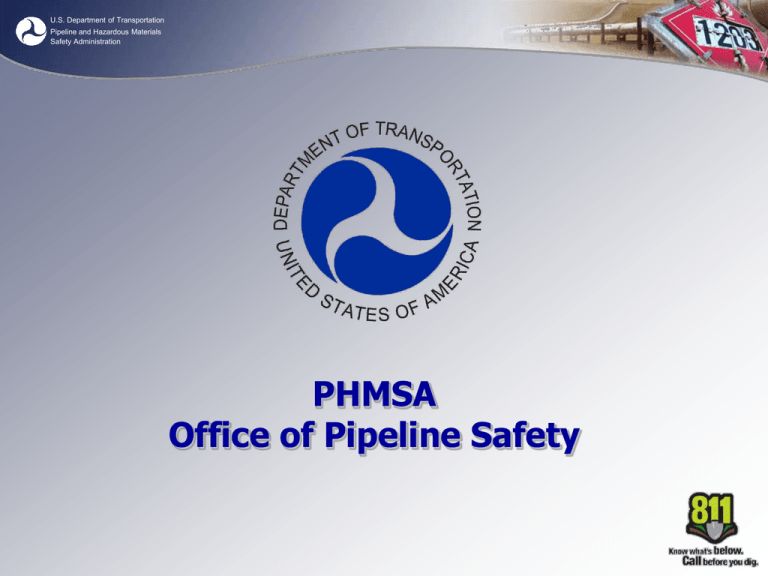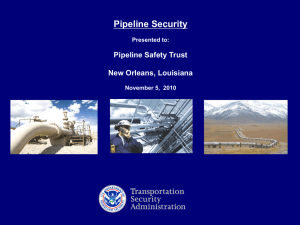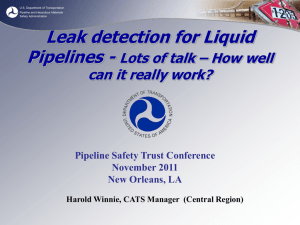PHMSA_Overview_RRT_III_OC_MD_5-16-2012
advertisement

U.S. Department of Transportation Pipeline and Hazardous Materials Safety Administration PHMSA Office of Pipeline Safety U.S. Department of Transportation Pipeline and Hazardous Materials Safety Administration Presentation Overview • Energy Pipelines • PHMSA Organization • Recent Spills • Pipeline Safety, Regulatory Certainty Act of 2011 (Reauthorization & new requirements) • PREP • Where to go for additional information U.S. Department of Transportation Pipeline and Hazardous Materials Safety Administration Energy Pipelines • Natural gas, crude oil and petroleum product pipelines extend across and into a majority of cities and counties in the U.S. • Our national economy and security depend on these products and our dependency on energy is growing – Energy from oil and natural gas essential to our daily lives • E.g., Transportation, heating, electricity generation • Oil and natural gas supply approx. 2/3 of U.S. energy needs • Oil and natural gas are produced in distant regions – Crude oil must be moved to refineries – Refined oil products & natural gas must be moved to consumers • Pipelines = primary means of transporting oil & natural gas – 100% of natural gas and approx. 67% of oil U.S. Department of Transportation Pipeline and Hazardous Materials Safety Administration U.S. Department of Transportation Pipeline and Hazardous Materials Safety Administration What is the Pipeline and Hazardous Materials Safety Administration? PHMSA U.S. Department of Transportation Pipeline and Hazardous Materials Safety Administration U.S. DOT Administrations http://www.dot.gov U.S. Department of Transportation Pipeline and Hazardous Materials Safety Administration Mission Statements “To protect people and the environment from the risks inherent in transportation of hazardous materials – by pipeline and other modes of transportation.” Office of Pipeline Safety Office of Pipeline Safety (within PHMSA) “To ensure the safe, reliable, and environmentally sound operation of the Nation’s pipeline transportation system.” http://phmsa.dot.gov/pipeline U.S. Department of Transportation Pipeline and Hazardous Materials Safety Administration Some of Our Roles and Responsibilities • Development and Implementation of Safety Regulations – Title 49 CFR Part 192 – Transportation of Natural and Other Gas by Pipeline – Title 49 CFR Part 195 – Transportation of Hazardous Liquids by Pipeline • Perform Comprehensive Inspections • Monitor and Enforce Compliance – Require remedial actions – Assess civil penalties – Initiate criminal action U.S. Department of Transportation Pipeline and Hazardous Materials Safety Administration Enforcement and Compliance • Operator compliance with pipeline safety regulations that establish minimal federal safety standards is critical to preventing pipeline accidents. Ensuring compliance involves regular inspections of pipeline operator programs and facilities and, when compliance violations are identified, the application of appropriate administrative, civil, or criminal remedies. • Federal and state pipeline inspectors conduct these compliance inspections and also conduct accident investigations and respond to public complaints concerning pipeline operations. U.S. Department of Transportation Pipeline and Hazardous Materials Safety Administration Recent Crude Oil Spills 2010 & 2011 • July 26, 2010, a 35-mile stretch of the Kalamazoo River near Marshall, Mich., once teeming with swimmers and boaters, remains closed nearly 14 months after an Enbridge Energy pipeline hemorrhaged 843,000 gallons of oil that will cost more than $500 million to clean up. U.S. Department of Transportation Pipeline and Hazardous Materials Safety Administration Exxon Mobil Spill in Montana • The company's 12-inch Silvertip pipeline broke beneath the Yellowstone one weekend last July 2011, releasing an estimated 63,000 gallons of oil. Less than 1 percent of the oil that spilled was recovered during a cleanup that cost an estimated $135 million. • Exxon Mobil Corp. is working with government agencies on a plan to speed up the response to oil spills along Montana's upper Yellowstone River, after a major spill last year left local officials scrambling to deal with an ill-defined threat, state and federal officials said. • The goal is to provide enough training and resources to take action on major pipeline, refinery or railway spills within 24 hours, or before outside help can arrive. U.S. Department of Transportation Pipeline and Hazardous Materials Safety Administration Reauthorization 2011 • New reauthorization law, “Pipeline Safety, Regulatory Certainty, and Job Creation Act of 2011,”. Several sections affect hazardous liquid pipelines: – Sec. 8. Leak detection. – Sec. 10. Transportation-related onshore facility response plan compliance. – Sec. 14. Biofuel pipelines. – Sec. 15. Carbon dioxide pipelines. – Sec. 16. Study of transportation of diluted bitumen. – Sec. 17. Study of nonpetroleum hazardous liquids transported by pipeline. U.S. Department of Transportation Pipeline and Hazardous Materials Safety Administration H. R. 2845 Pipeline Safety, Regulatory Certainty, …..Act of 2011 • SEC. 8. LEAK DETECTION. • Secretary of Transportation shall submit to the Committee on Commerce, Science, and Transportation of the Senate and the Committee on Transportation and Infrastructure and the Committee on Energy and Commerce of the House of Representatives a report on leak detection systems utilized by operators of hazardous liquid pipeline facilities and transportation-related flow lines………….. • and the safety benefits and adverse consequences of requiring operators to use leak detection systems. U.S. Department of Transportation Pipeline and Hazardous Materials Safety Administration Current Leak Detection Regulations • Current regulation do not prescribe a leak detection system for liquid operators, • However if an operator uses a Computation pipeline monitoring (CPM) system, it must comply with API 1130, • Operators with a SCADA system must have and follow written control room management procedures that implement requirements such as: – Define controllers roles and responsibilities, – Provide adequate information & training to controllers, – Establish a maximum limit on controllers hours of service U.S. Department of Transportation Pipeline and Hazardous Materials Safety Administration H. R. 2845 Pipeline Safety, Regulatory Certainty, …..Act of 2011 • SEC. 10. TRANSPORTATION-RELATED ONSHORE FACILITY RESPONSE PLAN COMPLIANCE • Reaffirms the Secretary of Transportation’s authority to enforce compliance with provisions of the Federal Water Pollution Control Act (Clean Water Act). The implementing Executive Orders (12777 and 13826) vested the authority to the Administrator (of U.S. Environmental Protection Agency), the Secretary of the Department of the Interior, and Secretary of the Department in which the U.S. Coast Guard is operating. • The existing oil spill response plan review and approval process remains intact. U.S. Department of Transportation Pipeline and Hazardous Materials Safety Administration Section 10 (con) • PHMSA will revise our internal handling of oil spill response plans, • Plans will become more transparent, with an increased emphasis on a reproducible and accountable approval process, • More technical on-site review of spill response data from our field inspections, • PHMSA looks to improve our interagency information sharing processes. U.S. Department of Transportation Pipeline and Hazardous Materials Safety Administration Section 15 Carbon Dioxide Pipeline • Section 60102(i) is amended— • (1) by striking ‘‘The Secretary shall regulate’’ and inserting • the following: • ‘‘(1) TRANSPORTATION IN LIQUID STATE.—The Secretary shall regulate’’. • (2) by adding at the end the following new paragraph: • ‘‘(2) TRANSPORTATION IN GASEOUS STATE.— • ‘‘(A) MINIMUM SAFETY STANDARDS.—The Secretary shall • prescribe minimum safety standards for the transportation • of carbon dioxide by pipeline in a gaseous state. U.S. Department of Transportation Pipeline and Hazardous Materials Safety Administration Sec. 16. Study of Transportation of Diluted Bitumen • Not later than 18 months after the date of enactment of this Act, the Secretary of Transportation shall complete a comprehensive review of hazardous liquid pipeline facility regulations to determine whether the regulations are sufficient to regulate pipeline facilities used for the transportation of diluted bitumen. U.S. Department of Transportation Pipeline and Hazardous Materials Safety Administration SEC. 17. STUDY OF NONPETROLEUM HAZARDOUS LIQUIDS TRANSPORTED BY PIPELINE • The Secretary of Transportation may conduct an analysis of the transportation of nonpetroleum hazardous liquids by pipeline facility for the purpose of identifying the extent to which pipeline facilities are currently being used to transport nonpetroleum hazardous liquids, such as chlorine, from chemical production facilities across land areas not owned by the producer that are accessible to the public. • The results of the analysis shall be made available to the Committee on Commerce, Science, and Transportation of the Senate and the Committee on Transportation and Infrastructure and the Committee on Energy and commerce of the House of Representatives. U.S. Department of Transportation Pipeline and Hazardous Materials Safety Administration SEC. 21. GAS AND HAZARDOUS LIQUID GATHERING LINES • The Secretary of Transportation shall conduct – a review of existing Federal and State regulations for gas and hazardous liquid gathering lines located onshore and offshore in the United States, including within the inlets of the Gulf of Mexico. U.S. Department of Transportation Pipeline and Hazardous Materials Safety Administration 60140. Cover over buried pipelines • The Secretary of Transportation shall conduct a study of hazardous liquid pipeline incidents at crossings of inland bodies of water with a width of at least 100 feet from high water mark to high water mark to determine if the depth of cover over the buried pipeline was a factor in any accidental release of hazardous liquids. • If the Secretary determines under paragraph (1) that the current requirements for the depth of cover over buried pipelines are insufficient, the Secretary shall develop legislative recommendations for improving the safety of buried pipelines at crossings of inland bodies of water with a width of at least 100 feet from high water mark to high water mark. U.S. Department of Transportation Pipeline and Hazardous Materials Safety Administration Preparedness for Response Exercise Program PREP • USCG published a Federal Register Notice asking for comments on the Preparedness for Response Exercise Program (Docket USCG-2011-1178), (closed April 23, 2012. • The Oil Pollution Act required that owners and operators of oil-handling facilities submit oil spill response plans for approval, and that each have an exercise program to validate the elements of their oil spill response plans. U.S. Department of Transportation Pipeline and Hazardous Materials Safety Administration PREP continued • PREP first published in 1994, as a joint effort to reduce the need for the industry to have to satisfy different exercise (drill) requirements placed by different agency regulations. • Guidelines Last revised in 2002. • Joint committee (USCG, USEPA, DOT/PHMSA, and DOI/BSEE) meeting to begin work on comments. • PREP Guidelines are not regulations, but can help the owner and operators of facilities that are regulated by more than one agency receive credit for conducting drills among the federal agencies with jurisdiction. U.S. Department of Transportation Pipeline and Hazardous Materials Safety Administration Other Important Links • PHMSA, Office of Pipeline Safety – www.phmsa.dot.gov/pipeline • For Federal Regulations – www.regulations.gov U.S. Department of Transportation Pipeline and Hazardous Materials Safety Administration Thank You Alex Dankanich (202) 550-0481 alex.dankanich@dot.gov





